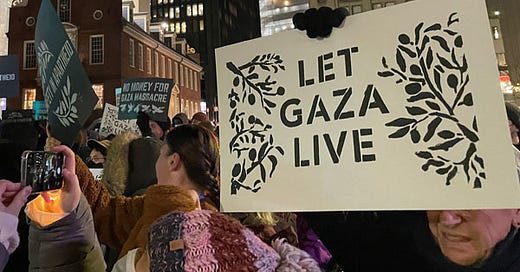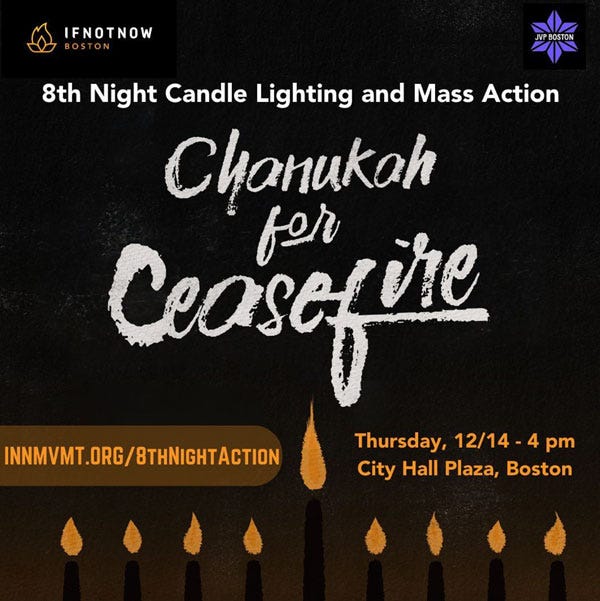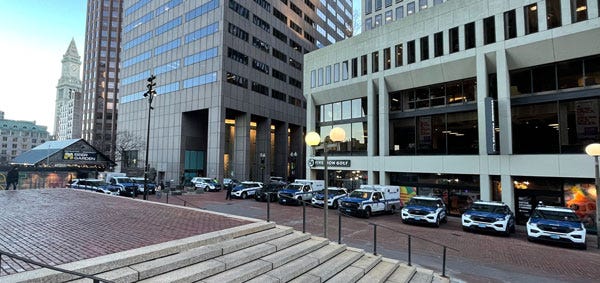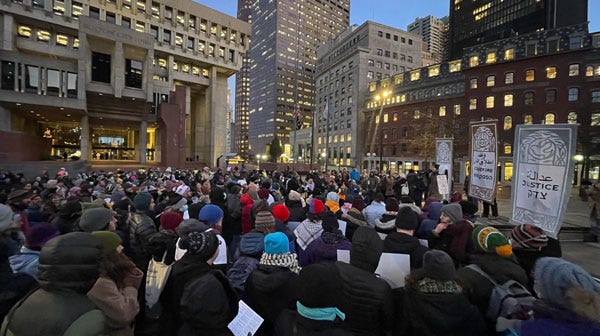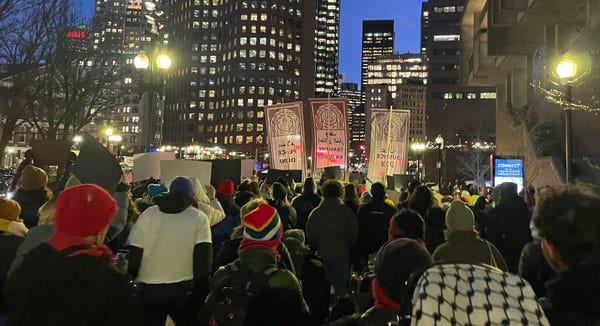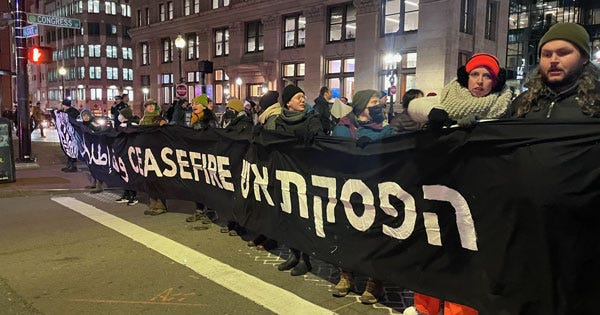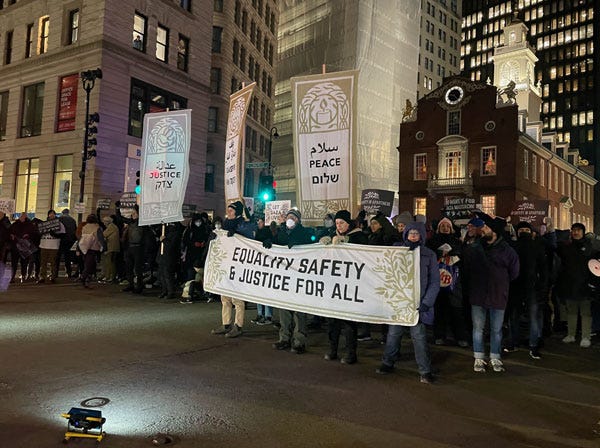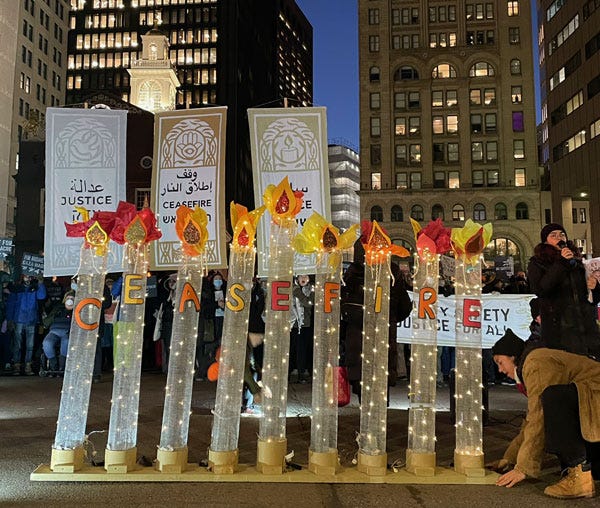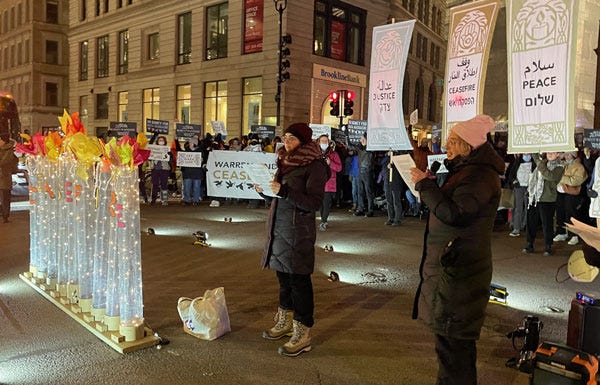Welcome to another edition of Willoughby Hills!
This newsletter explores topics like history, culture, work, urbanism, transportation, travel, agriculture, self-sufficiency, and more.
If you enjoy what you’re reading, please consider a free subscribtion to receive emails every Wednesday and Sunday plus podcast episodes every two weeks. There are also paid options, which unlock even more features.
While I have always followed politics fairly closely, I have never been a very politically active person. This may surprise some of you, especially as this newsletter has become increasingly politically charged since October 7, but I tend to favor changing minds and opinions through my writing rather than participating in direct actions like phone banking, knocking on doors, or engaging in protests.
Of course, as the situation in Gaza has continued to deteriorate, I have felt that writing alone is not enough. The U.S. government is supplying aid money and weapons to Israel and voted against a United Nations resolution calling for an immediate ceasefire last week. (153 countries voted in favor of the ceasefire, while the U.S., Israel, and eight other countries voted against it).
This is being done in our name, and I feel the need to condemn what is happening in every way that I possibly can. I felt inspired to try to use my voice and my body to stand for change and decided to attend an event last week.
In today’s post, I’d like to share some of my experience and reflections on what it was like attending a pro Palestine protest, especially for those of you who may also be trying to decide how best to get involved and use your own voice during this time.
I have been following accounts like Jewish Voice for Peace and If Not Now on Instagram, both Jewish led organizations that are fighting for Palestinian liberation. If Not Now announced a candle lighting and mass action commemorating the eighth night of Chanukah in Boston last week. As soon as I saw the post, I knew I had to attend.
I happened to be working in Boston that day and decided to head to the event after work. I didn’t read anything beyond the one Instagram post, which had a date and location. I didn’t register or RSVP- I just decided I would show up and be a part of the crowd.
When I arrived, there were already maybe 100 or so people milling about and getting set up. There was also a police presence, with maybe a dozen squad cars and a few paddy wagons staged near City Hall.
The activists all appeared to be young Jewish college students or other people that were well acquainted with each other. There were a lot of hugs and warm greetings.
I was there by myself and didn’t recognize anybody, but I stood and observed. I kept thinking of something I heard Amanda Gelender say to
on the Here4TheKids podcast last week:“Let the movement catch you.”
I was a stranger to these people and them to me, but we were there for the same reason. I decided to let go and let the movement catch me. I saw myself as a part of this group and them a part of me.
At one point, the people there began to break into “teams” and began to discuss plans with each other. It was clear that this was going to be more than just a vigil, although I wasn’t sure what to expect.
A young organizer came up to me at one point and asked which team I was on. I told her I didn’t have a team; I had seen the posting on Instagram and decided to show up to show my support. She explained to me that there was going to be an action of blocking traffic and that the teams were divided up based on the risk or getting hurt and/or arrested.
There were trained activists who planned to put their bodies on the line to stop traffic, expecting to get arrested. There were others who were willing to be involved who might get arrested. And there was also just the option to be a part of the crowd and participate without being involved directly in the action portion. I told her that I was most comfortable observing and voicing my support, rather than being put in any position for a confrontation.
Soon after, a few people began speaking though bull horns. There were prayers and songs and chants. There was also a briefing. We were told that there were medics, there was an accessibility person who could help anybody with mobility issues by providing chairs and other access, and there was even a media liaison who we were supposed to direct all questions to if a member of the press approached us.
Signs were handed out to those that wanted them. Song sheets were also distributed with the lyrics printed. These sheets also had QR codes to scan and take further action after getting home.
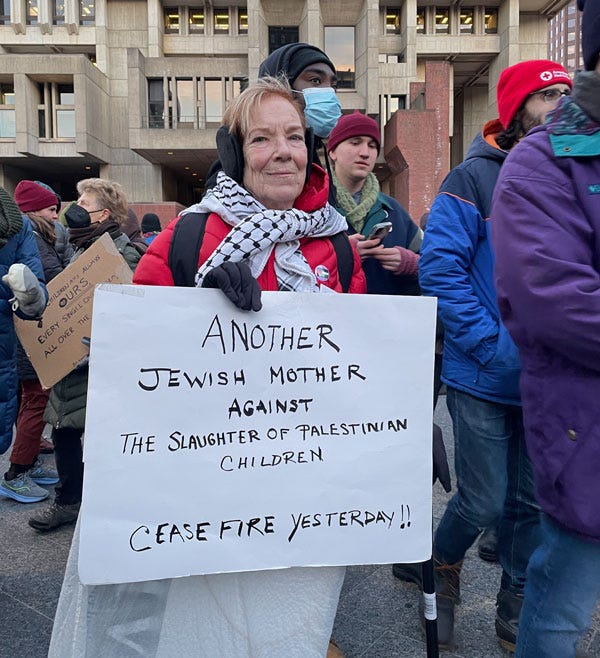
By this point, the crowd was probably in the hundreds and included a diverse mix of folks. The majority were Jewish, but there were people of all backgrounds. There was also quite the range of ages, from young toddlers to elderly women and men. It was really a cross section of ages, races, genders, and religions.
The march then stepped off and we followed banners that read “Peace,” “Justice,” and “Ceasefire” across City Hall Plaza and down towards the street. A small brass band played music as we marched, while others beat simple drums made from five gallon buckets. It conjured memories of being in my high school marching band again. As we marched, we chanted for a ceasefire.
Police had blocked off the road for us, and we stepped into Congress Street right in front of the Holocaust Memorial. We marched up the street, passing Faneuil Hall, a landmark dating to 1742 where famous orators like Samuel Adams made the case for American Independence. (I wrote about Faneuil Hall, authenticity, and pizza earlier this year.)
As we reached the intersection of Congress and State Streets, the procession stopped. Some folks unfurled banners that read ceasefire and proceeded to block the traffic that was in the intersection, including a city bus.
Police were present, but no attempt seemed to be made to ask the protestors to stand down or to stop blocking traffic.
The hundreds of us that were part of the march were all gathered in the intersection. The Old State House, once the center of British colonial government and the site of the Boston Massacre in 1770, served as the backdrop as organizers set up a giant menorah and unfurled their banners, using battery powered LED lighting to ensure they could be well seen.
A PA system appeared and people from If Not Now and Jewish Voice for Peace began speaking and singing. The event had all of the formality and organization of a political rally, it just happened to be taking place in the middle of one of the busiest intersections in Downtown Boston.
TV news cameras covered the proceedings live during the evening news and photographers for the Boston Globe snapped photos. A helicopter circled overhead, but it was too dark to tell if it belonged to a news station or the police.
For more than an hour, I stood shoulder to shoulder with hundreds of people in the freezing cold, singing songs, chanting, and in particular, calling on Senators Ed Markey and Elizabeth Warren to call for a permanent ceasefire.
On the one hand, I questioned whether my presence at the event really made that big of a difference. I was just one person in a sea of other people. What impact did my presence really have?
I wrestled with that question prior to even attending the rally, but one of the biggest answers I could find was that I was modeling for my children the power of speaking up. They didn’t attend, but they knew that I would miss dinner last Thursday because I was marching to support an end to violence. I want them to have that as a core part of their being, to understand that we don't have to accept things as they are and can work to change the world.
On a recent Zoom call for
, somebody (apologies, I don’t remember who) shared some wisdom which also helped me realize the importance of showing up. That person said something like:“Small drops make the flood.”
It’s true that we are each just small drops of water alone, but when put together, those drops become a force.
By about 6:00, I was starting to get very cold and tired. The rally still had a lot of energy and seemed to be nowhere near an ending point. A part of me wanted to stay until it ended, knowing that just as small drops make a flood, a small leak can also drain a bathtub fairly quickly. If I left, I worried about my neighbors leaving and the whole event falling apart.
I also felt guilty wanting to leave so that I could get home to see my kids before bed. The point of the rally was to speak up for Palestinians who don’t have a voice right now, let alone a bed to sleep in or even adequate food. It felt overly privileged to want to leave when other people don’t have that luxury.
I was standing fairly near to the “stage” section where the speakers were all talking through microphones. One of the emcees, a young woman, walked off at one point and began to cough. An older woman in the crowd put a hand on her shoulder and I heard the older woman say to the younger one something like: “Take care of yourself. It’s a long road ahead.”
In that moment, the older woman was speaking from a place of experience and was also speaking a universal truth. She could have been talking about the event that night, but she could also be talking about the fight to end the current struggle, or even about the fight to ensure justice and equality all over the world. It’s a long road ahead no matter how you look at it. And she had clearly been living it.
There was something about that sentiment that made me feel like it was okay to sneak out a little early. I had shown up. I had participated. My drop helped make the flood. But it is a long road and it’s okay to sometimes have to stop for gas, or food, or the restroom on that journey.
I left the energy and excitement of the march behind me and headed to the train station. I may have been leaving that evening, but the movement was catching me too. I’ve always known the power of our voices to speak up, but it was nice to see the power the human body can have by taking up space and standing up.
Thanks for reading Willoughby Hills! Subscribe for free to receive new posts and support my work.
Related Reading
If you’ve missed past issues of this newsletter, they are available to read here.


